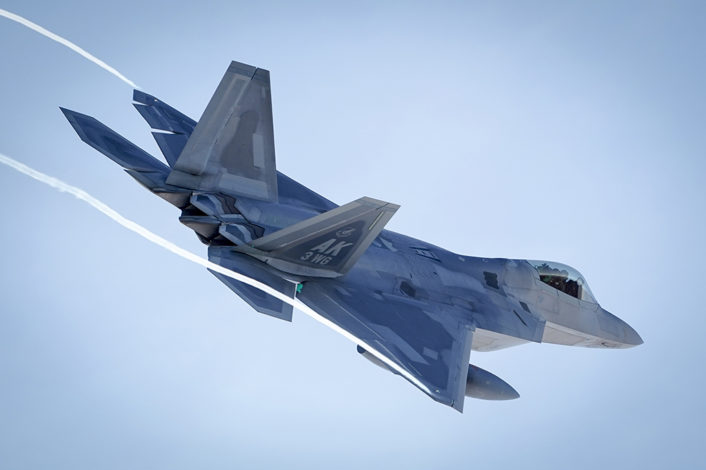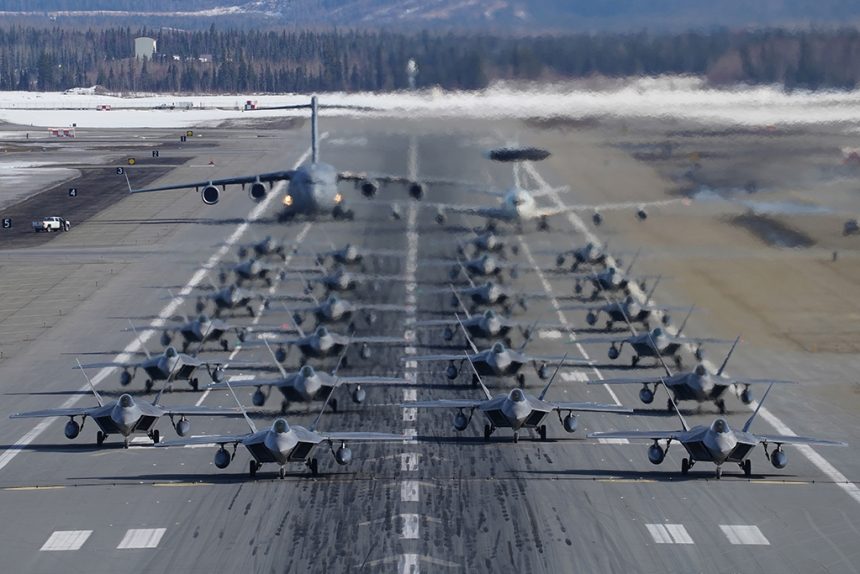24 Raptors an E-3 Sentry and a C-17 Globemaster III took part in a readiness exercise at JBER in Alaska.
Some really cool photographs of two dozen F-22s from the 3rd Wing and 477th Fighter Group taxiing in close formation with an E-3 Sentry and a C-17 Globemaster III during a Polar Force exercise at Joint Base Elmendorf-Richardson, Alaska, were posted online on Mar. 26, 2019. Both types are based at JBER.
The aircraft staged what is known as an “Elephant Walk”, a kind of drills during which combat planes (including tankers) taxi in close formation in the same way they would do in case of a minimum interval takeoff, then, depending on the purpose of the training event, they can either take off or return back to their parking slots.
What is particularly interesting in the photos of the exercise at JBER, is the fact that, along with the Raptors, also a Sentry took part in the “walk”.
3rd Wing’s F-22s and E-3s often team up during QRA (Quick Reaction Alert) launches triggered by Russian long-range bombers flying in the vicinity of the Alaskan ADIZ (Air Defense Identification Zone). This is what we wrote in 2017 about such “combined scrambles”:
Launching the AEW along with the fighters is a “tactics” that allows the Air Defense to extend the radar coverage and to better investigate the eventual presence of additional bombers or escorting fighters flying “embedded” with the “zombies” (as the unknown aircraft are usually dubbed in the QRA jargon). At the same time, the presence of an E-3 allows the Raptors to improve their situational awareness while reducing the radar usage and maximizing as much as possible their stealth capability (even though it must be remembered that F-22s in QRA usually carry fuel tanks that make them less “invisible” to radars).
A long range sortie is not easy to plan. Even more so a strike sortie: the bomber are not only required to fly inbound the target (TGT) and reach a convient position to simulate the attack and weapons delivery, they also need to take in consideration many other factors. First of all “what is your goal?” Do you want to train for a realistic strike? Or do you want to “spy” or show your presence or posture?
Other factors are distance from own country, opponent’s defense capability, minimum risk routing according to the threats, presence of DCA (Defensive Counter Air), supporting assets, etc.
Usually, during a strike sortie, bombers are considered the HVA (High Value Asset), the one that must be protected. For this reason during the planning phase they are always escorted by fighter and protected by the Ground to Air threats by means of SEAD/DEAD (Suppression/Destruction of Enemy Air Defenses), EW (Electronic Warfare) and everything is needed to let them able to hit their targeted.
However, escorting a strategic bomber is not always possible (nor convenient): considered their limited range, the presence of the fighters would heavily affect the long range planning, requiring support from multiple tankers along the route.
For this reason, although the Russians visit the West Coast quite often, they usually are not escorted by any fighter jet (as happens, for instance, in the Baltic region, where Tu-22s are often accompanied by Su-27 Flankers).
However, it’s better to be prepared and trained for the worst case scenario and this is probably the reason why NORAD included an E-3 AEW in the QRA team: to have a look at the Tu-95s and make sure there was no “sweep” fighters or subsequent “package”.
The configuration of the F-22 aircraft involved in the Elephant Walk at JBER is also interesting as the stealth jets carry underwing tanks: that is the standard external loadout both in case of QRA launch and for ferry flights and forward deployments.
After taking the shots, the aircraft cleared the runway, taxied back to the threshold of RWY24 and took off in sequence.

As already reported a recent “Elephant Walk”, also involving about two dozen F-22s, took place at Joint Base Langley-Eustis, Virginia, on Feb. 28, 2019.









